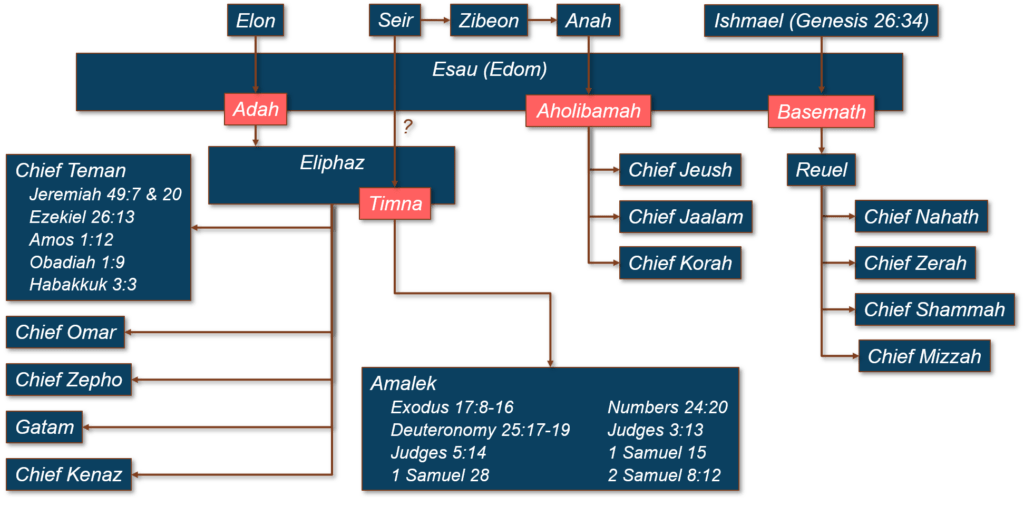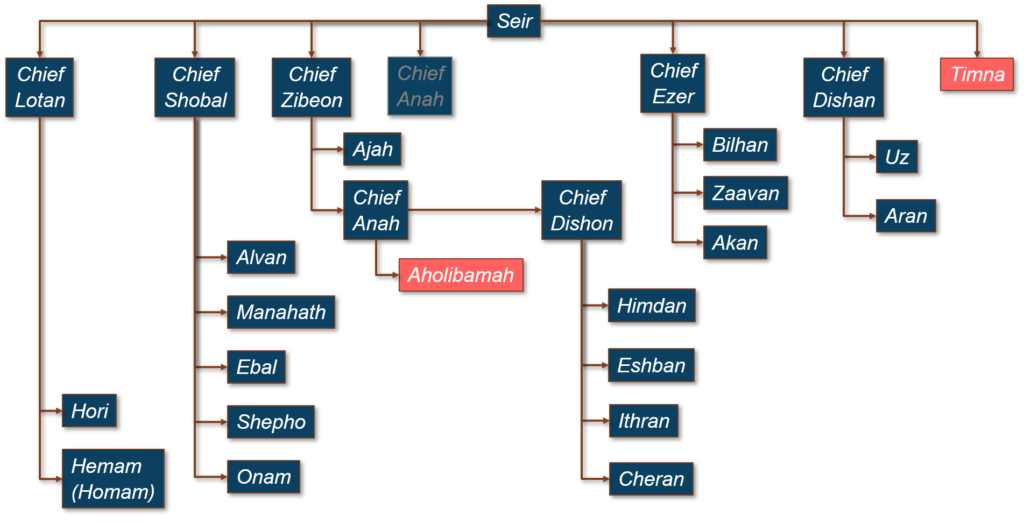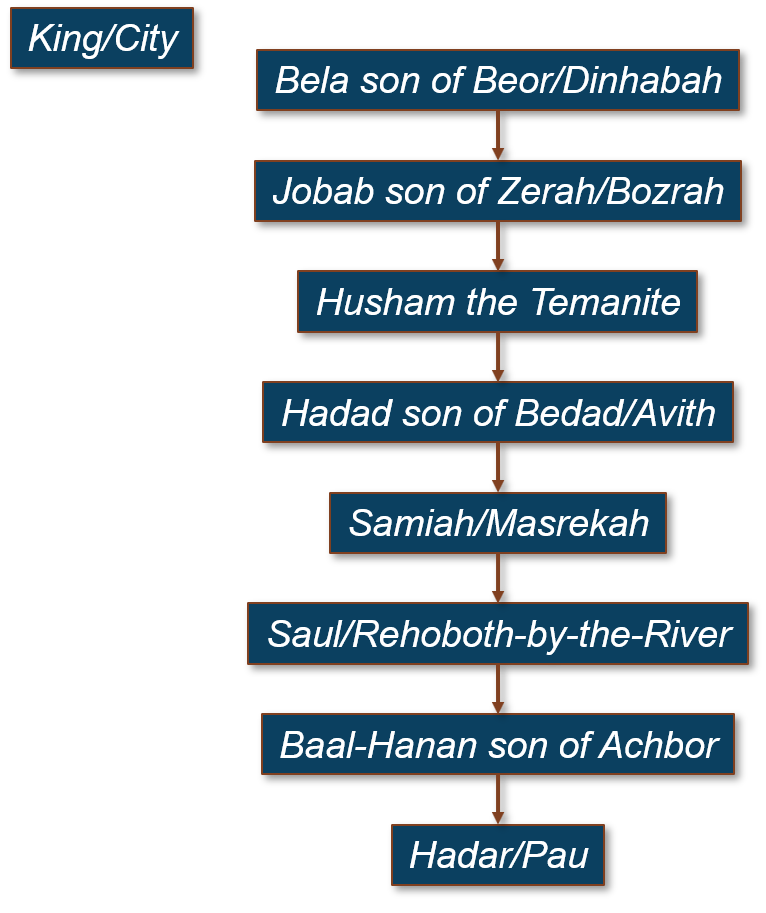Calvary Chapel – Leesville, SC Wednesday Evening Service – December 30th, 2020
Review
So far, Genesis has focused on giving us the lineage of the Messiah first promised in Genesis 3:15 from Eve to Abraham’s grandson Jacob – the patriarch of God’s chosen people Israel through whom God would eventually bring forth our Savior Jesus. Starting in Genesis 25 and continuing through Genesis 35, the story focused on Jacob himself. Starting in Genesis 37, the focus shifts to Jacob’s second-youngest son Joseph, and will remain on him for the remainder of the book. But first, God’s Word briefly departs from the main theme of Genesis to list some of the descendants of Jacob’s twin brother Esau along with some of the family of Seir, whose lands Esau’s descendants inhabited.
Genesis 36 – The Genealogy of Esau
Although the family of Jacob (Israel) is the main focus of Genesis, Esau and his family are also important. Some of Esau’s descendants in particular played important roles in the history of the Israelites. There is little to be gained by simply reading out these lists of names. In fact, I will depart from my usual practice in this lesson, and won’t even quote the chapter verse-by-verse. Instead, we’ll look at the family trees given in this chapter, so we may better understand the relationships among these people. As we go, we will note some the people who play significant roles in the history of Israel apart from merely being listed in the various genealogies.
NOTE – When considering genealogies, it is always important to remember that no genealogy is ever complete. This stands to reason when we consider that any complete genealogy would include over ten billion entries, and would have to be updated five times or more per second to keep up with the world’s ever-changing population. Therefore, Biblical genealogies – like all genealogies – are limited in scope. They are given for a specific purpose, and offer a view of family relationships limited to that purpose. The genealogies given in Genesis 36 are included because of the part that some of Esau’s and Seir’s descendants were to play in the later history of God’s chosen people Israel. Furthermore, we must always remember that Biblical names – like names in general – are often reused, and sometimes the Bible gives variant spellings for a given name. Finally, although we firmly hold that all scripture is God-breathed, and completely without error in its original form, the transcribed copies of the Bible which have survived to come down to us do contain occasional transcription errors. We must always keep that fact in mind. Therefore we need to be careful in drawing any hard and fast conclusions from Biblical genealogies.
With all that said, we may garner great benefits from studying these genealogies, which allow us to better understand the relationships among the people listed.
Genesis 36:1-19 – The Family of Esau & Chiefs of Edom

Genesis 36:1-14 provides a listing of some of Esau’s descendants born to three of Esau’s wives – Adah, Aholibamah, and Basemath (female names shown in pink). Of these descendants, some are listed as “Chiefs of Edom” in Genesis 36:15-19. Recall from Genesis 25:30 that Esau [עֵשָׂו `Esav – hairy] was also called Edom [אֱדֹם ‘Edom – red] after he sold his birthright as the firstborn of Isaac to his younger twin brother Jacob for some stew of red lentils. The name Edom is also used for the land of Seir east of the Dead Sea where Esau settled following his reunion with Jacob in Genesis 33.
Esau’s wife Basemath was his cousin – the daughter of his uncle Ishmael. Basemath bore Esau’s son Reuel, who in-turn had four sons who became chiefs of Edom.
Esau’s wife Aholibamah bore him three sons who are also named as Chiefs of Edom. Aholibamah was the great-granddaughter of Seir the Hivite – progenitor of the people who occupied the land where Esau eventually settled. The first mention of Aholibamah gives rise to questions.
Esau took his wives from the daughters of Canaan: Adah the daughter of Elon the Hittite; Aholibamah the daughter of Anah, the daughter of Zibeon the Hivite;
Genesis 36:2 – NKJV
Yet in verses 20 and 24 Zibeon and Anah are listed as the son and grandson of Seir respectively, not son and granddaughter. How can we explain this seeming conflict? Some possible explanations…
- Possibly, Zibeon had a son and daughter both named Anah. This seems very unlikely. One would think that a father would have to have been hit on the head repeatedly to cause him to give his children identical names. George Foreman springs to mind… but I digress.
- There may have been a transcription error in Genesis 36:2 somewhere along the way from the original text to the surviving copies available today. In fact, some of the available texts list Anah as the son – not the daughter – of Zibeon in Genesis 36:2. The Hebrew words for son and daughter are very similar [בַּת bath – daughter and בֵּן ben – son], so this would be a very easy error for a scribe to make.
- The second instance of בַּת bath in Genesis 36:2 is referring to Aholibamah, not Anah, so it might better be translated as “granddaughter” rather than “daughter.” In fact, the NLT, NIV, CSB, and NASB do render the verse in this way.
Esau’s wife Adah was the daughter of Elon the Hittite. The Hittite empire was centered in modern Turkey and extended southward into what is now Lebanon and northern Israel. Adah bore Esau one son – Eliphaz. Several sons of Eliphaz are listed in Genesis 36, four of whom are also named as Chiefs of Edom. Of these, two are mentioned elsewhere in God’s Word outside the genealogies found in Genesis 36 and 1 Chronicles 1. Chief Teman is mentioned in the prophecies of Jeremiah, Ezekiel, Amos, Obadiah, and Habakkuk. In these prophecies, Teman is taken as the “poster child” for all of the declarations against the land and people of Edom. Perhaps this is because Eliphaz was the firstborn of Esau, and Teman was the firstborn of Eliphaz.
Eliphaz had a concubine named Timna. In Genesis 36:12, Timna is listed as the sister of Seir’s son Lotan. Thus, Timna was the name of one of Seir’s daughters. Thus our family tree of Esau’s descendants shows Eliphaz’s concubine Timna as Seir’s daughter. Note that Esau’s son Epliphaz is shown in the diagram as having Seir’s daughter as a concubine, while Eliphaz’s father Esau is shown married to Seir’s great-granddaughter Aholibamah! We are thus left to wonder whether Timna was extremely old when she bore Eliphaz’s son Amalek, or possibly Eliphaz’s concubine Timna isn’t the same person as Seir’s daughter Timna. The latter seems much more likely, so the connection in our diagram between Seir and Timna is marked with a question mark.
Regardless of all that, by far the most significant of all Esau’s descendants in the history of Israel is Timna’s son Amalek.
- Exodus 17:8-16 – As the Israelites were making their way from Egypt after God divided the Red Sea so they could escape from Pharaoh’s pursuing army (Exodus 15), the descendants of Amalek attacked the Israelites at a place called Rephidim. Whenever Moses held up his staff, the Israelites prevailed, but whenever Moses lowered his arms the Amalekites prevailed. So Moses’ brother Aaron and Hur held up Moses’ arms until the Israelite army under the command of Joshua won the battle.
- Numbers 24:20 – Balaam son of Beor prophesied the destruction of the Amalekites.
- Deuteronomy 25:17-19 – God directed the utter destruction of the Amalekites by the Israelites as recompense for the Amalekites’ atttack on Israel at Rephidim.
- Judges 3:13 – The Amalekites allied with the Amonites and Moabites to defeat Israel in battle at the City of Palms, and the King of Moab then ruled over the Israelites for eighteen years before God raised up Ehud the judge to defeat him.
- Judges 5:14 – Amalek is mentioned in the song of Deborah the prophetess following the defeat of the army of King Jabin of Canaan by Barak the judge at Mt. Tabor.
- 1 Samuel 15 – Through Samuel, God commanded King Saul to utterly destroy the Amalekites including all of their men, women, children, livestock, and material goods, but Saul disobeyed by taking the King of the Amalekites captive, and seizing spoils and slaves from the Amalekites. Because of this disobedience, God removed the kingdom from Saul.
- 1 Samuel 28 – Saul consulted a spiritualist. She called up Samuel’s spirit who confirmed that God would remove the kingdom from Saul through defeat in battle with the Philistines due to his failure to wipe out the Amalekites.
- 2 Samuel 8:12 – King David dedicated spoils taken from the Amalekites to the LORD.
Genesis 36:20-30 – The Family of Seir

The descendants of Seir were the occupants of the area east of the Dead Sea when Esau came to live there. No ancestry of Seir himself is given in God’s Word. The descendants of Seir were eventually absorbed under the rule of the descendants of Esau (Edom). God gave the land of Seir to Esau’s descendants just as He gave the land of Canaan to Israel (Deuteronomy 2:1-5). The most notable descendants of Seir are Zibeon his son, Anah his grandson, and Aholibamah his great-granddaughter who became Esau’s wife.
NOTE – Genesis 36:20 lists Anah as the son of Seir alongside the other five sons and one daughter of Seir shown here. It is possible that Seir had both a son named Anah about whom nothing further is mentioned and also had a grandson of the same name who was the son of Zibeon and father of Esau’s wife Aholibamah. It is also possible that in light of Anah’s importance as Esau’s father-in-law that he is listed along with his father, uncles, and aunt as a “son” of Seir instead of a “grandson.”
Genesis 36:31-39 – Kings of Edom

Little can be determined Biblically about the time these kings reigned in Edom or their genealogical relationships to the descendants of Esau and Seir apart from the clear statement in Genesis 36:31 that they reigned before there was a king in Judah. Thus the reigns of these kings of Edom must have been during the time of the judges in Israel, and possibly even before.
NOTE – In Genesis 36:38 we find the first mention of the name Baal [בַּעַל Ba`al – lord]. This was a generic Hebrew word applied to various Canaanite gods. Recall that the prophet Elijah confronted and executed 450 prophets of Baal at Mt. Carmel (1 Kings 18). In the case of the Edomite king Baal-Hanan however, the name Baal was likely just an honorary title – “Lord Hanan” – rather than a reference to the Canaanite idols.
Genesis 36:40-43 – Chiefs of Esau

The names of the chiefs of Esau given in Genesis 36:40-43 are simply listed without reference to any time period, family relationships, or geographical location. Some of these names are familiar from the genealogies given earlier in the chapter and elsewhere. These may be the same people, or others with identical names. I assume all of these chiefs were men, although the names Aholibamah and Timna were given earlier in the chapter as women’s names.
Invitation/Prayer
If you are reading this post and do not know Jesus as your own redeemer and LORD, the Bible says that today is the day of salvation. The Gospel is straightforward.
God created mankind for fellowship with Him – that we would love, honor, and worship Him for all eternity. But the day Adam and Eve disobeyed God’s command not to eat the fruit of the tree of the knowledge of good and evil, sin and death entered into the world breaking our fellowship with God who being perfectly holy cannot abide in the presence of sin. All of us who are descended from Adam and Eve were born with a sinful nature. Furthermore every one of us chooses to sin each and every day. None of us perfectly fulfills the commandments of God. Being sinful by nature, none of us ever could. Worst of all, God tells us in His Word (Romans 6:23) that the rightful punishment for our sins – large and small – is death.
Yet God created us specifically to dwell for all eternity in the joy of His presence. Therefore, God made a way for sinful mankind to be reconciled to Him despite our sinfulness. God Himself became a man in the flesh of Jesus of Nazareth. Jesus lived the perfectly sinless life that we are incapable of living due to our sinful nature. Thus Jesus was able to become the perfectly sinless sacrifice God required for the remission of sin. Jesus voluntarily gave His own life on the cross – taking the punishment for our sins upon Himself, and exchanging our sinfulness for His perfect righteousness. Furthermore, Jesus demonstrated His victory over sin when He rose from the grave on the third day by the power of His own Spirit. He has now ascended to the glory He has shared with the other two members of the Holy Trinity – God the Father and God the Spirit – since before the creation of the world. When He ascended to Heaven, Jesus left us with the promise that one day He will return to gather His followers to Himself. Jesus taught (John 3:16-17) that anyone who believes in Him will never die, but He will give them eternal life in the presence of His glory in Heaven.
The Bible gives us specific instructions (Romans 10:8-9) for how we must claim this gift of eternal life for ourselves. First, we must truly believe in the depths of our being that Jesus has been raised from the dead. Then, believing in His resurrection, we must proclaim aloud our intention to follow Jesus as our LORD and savior – forsaking our sins, and devoting ourselves entirely to Him, however He might call us to serve Him and those around us. He promises that when we make the commitment to follow Him, He will fill us with His Spirit and abide with us and within us from that moment forward for all eternity.
Jesus also clearly taught that no one can come to Him in this way unless God the Father draws them to Him by the power of His Spirit. So knowing now the Truth of the Gospel of Jesus, if God’s Spirit is calling you to to believe the Gospel and be saved, do not harden your heart against Him. God wants us to know, love, and worship Him in spirit and in truth. God knows that love must be a choice. He can’t and won’t force Himself upon us. He has given us the power to choose whether to accept His Gospel and enter back into eternal fellowship with Him or to reject it and continue on our way alone. Choose wisely.

I have heard that the line of Esau flows all the way to Amelak to Haman to Herod to Yassar Arafat
Do you have a chart showing that ?
Hi Susan,
I’m sorry, but I don’t have such a chart. The diagram you see in this post contains only what I was able to glean directly from God’s Word – Specifically, Genesis 36. Obviously Yassar Arafat is not mentioned in the Bible. Nor does God’s Word contain any information I am aware of that details the genealogies of Haman and Herod (assuming you mean Herod the Great). BTW – I am so sorry it took me so long to respond. Apparently my security plugin has gotten overly aggressive in trashing comments to my posts.